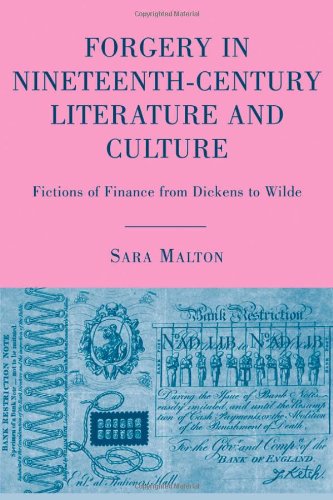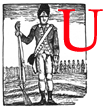[Thanks to James Heffernan, founder and editor-in-chief of Review 19 for sharing this review with readers of the Victorian Web. — Katherine Miller Weber]

 ntil the 1830s in England, forgery was a crime comparable to murder: both were punished by hanging. While previous scholarship on forgery, such as Ian Haywood's Faking It: Art and the Politics of Forgery (1987) and Paul Baines's The House of Forgery in Eighteenth-Century Britain (1999), focuses on the aesthetic and literary histories of forgery, this book interrogates its criminal history and its haunting influence on the Victorian cultural imagination. As Malton explores how such "petty crimes" as forging and circulating bank notes could equal "destruction of sacred bodies" (31), she convincingly reformulates forgery as a cultural archetype of the period. Forgery incited fears in the Victorian imagination that reached beyond its legislative boundaries. In her analysis of novels, Malton expands her definition of forgery to argue that a person's identity is also a text that can be forged, such as a woman's illegitimate child or a man's phony public image. Deftly moving between forgery legislation, historical cases of prominent swindlers, and fictional interpretations of fraud, Malton shows how forgery in the nineteenth century came to symbolize fundamental concerns about the validity of origins and the reliability of appearances.
ntil the 1830s in England, forgery was a crime comparable to murder: both were punished by hanging. While previous scholarship on forgery, such as Ian Haywood's Faking It: Art and the Politics of Forgery (1987) and Paul Baines's The House of Forgery in Eighteenth-Century Britain (1999), focuses on the aesthetic and literary histories of forgery, this book interrogates its criminal history and its haunting influence on the Victorian cultural imagination. As Malton explores how such "petty crimes" as forging and circulating bank notes could equal "destruction of sacred bodies" (31), she convincingly reformulates forgery as a cultural archetype of the period. Forgery incited fears in the Victorian imagination that reached beyond its legislative boundaries. In her analysis of novels, Malton expands her definition of forgery to argue that a person's identity is also a text that can be forged, such as a woman's illegitimate child or a man's phony public image. Deftly moving between forgery legislation, historical cases of prominent swindlers, and fictional interpretations of fraud, Malton shows how forgery in the nineteenth century came to symbolize fundamental concerns about the validity of origins and the reliability of appearances.
In Victorian society as Malton presents it, the transition from tangible property ownership to intangible capital contributed to the "often troubling unreliability of representations of value" (4). Representations of value no longer reliably indicated either history or identity, no longer certified either the authenticity of a signature or the content of one's character. To buttress this point, Malton links instances of literal forgery to the appearance of economic, legal and social instabilities that emerge in consequence of forged identities. In 1824, for instance, the case of Henry Fauntleroy, "one of England's most notorious forgers" (32), disrupted the English public's faith in the banking system; while Fauntleroy was forging the powers of attorney over the course of ten years, he maintained the appearance of a respectable citizen and trustworthy banker. Citing Wilkie Collins's invocation of Fauntleroy in The Woman in White (1860-61), Malton shows that since economic relationships can establish a "blood-tie" between individuals, any violation of that trust violates life itself. Thus, Malton notes, forgery was "increasingly envisioned as an attack on the life-blood of a nation dependent on expanding commerce and trade" (20). The forger, in representative histories and fictions, "enacts a violation of genealogy" and "threatens to pollute sound, original 'stock'" (42).
If appearances proved deceptive in both signatures and character, upon what criteria could Victorians rely to determine the validity of financial transactions? If truth could not be derived from appearances, perhaps it could be found in the body. In Victorian novels, Malton notes, "the Physician is accorded special access to knowledge of the truth, which . . . is in the body, inscribed in the blood" (75). The concealment of this truth is a forgery and likewise a "crime of the first magnitude" (1). Especially problematic was the body of the infant, since questions of identity were often wrapped in problems of legitimacy. In Elizabeth Gaskell's Ruth [outside the Victorian Web] (1853), for instance, an illegitimate child becomes a forged text. Ruth's son, Malton writes, "acts as a textual document that articulates the truth of her crime, a document that Ruth . . . forges into a feigned identity that would conceal the truth" (59). Rather than admit to the world that her son was born out of wedlock, Ruth adopts the persona of a widow, granting her and her son access to a respectable position in society. Juxtaposed with this story of illegitimacy is the story of Richard Bradshaw, son of a respectable gentleman, and his forgery of signatures on insurance shares. Both forgeries come to light at the climax of the novel and both threaten to disrupt the reliability of bloodlines as indicators of morality. But as Malton observes, these two forgeries differ sharply in their consequences. While Ruth is ostracized from the community for what amounts to a social lie, Richard is let off comparatively easy for having committed a capital crime. Malton thus shows how forgery infected multiple strata of Victorian culture and was punished unevenly according to one's social class or gender.
In the nineteenth century, forgery could be viewed as not just criminal but also politically subversive. According to Malton, Gaskell's representation of Ruth's sexual transgression and subsequent concealment of her illegitimate son exposes the prejudicial "structures of patrilineal inheritance and ownership" that "put the innocent at perpetual risk" (60). In Dickens's Barnaby Rudge (1841), as Malton notes, another unwed mother turns to literal forgery. Instead of passing off an illegitimate child as legitimate, she forges banknotes in order to survive, and is consequently executed for "passing bad Notes" (24). These two examples invite more study of how Victorian authors treated forgeries committed by weaker members of society. Although Malton examines the juxtaposition of literal and metaphorical forgeries in Victorian fiction and Victorian life, she most frequently treats forgery as a white-collar crime committed by men who seek to gain at the expense of others. Her occasional moves beyond this category suggest that forgery could be further investigated as an act of resistance by weaker members of Victorian society.
At the end of the nineteenth century, Victorian literature challenged the trustworthiness of British institutions by depicting them, according to Malton, as "unreliable repositories of knowledge and guarantors of identity" (94). In Stevenson's Dr. Jekyll and Mr. Hyde (1886), Hyde effortlessly accesses Jekyll's reputation and fortune, subverting the authority of the law and the jurisdiction of banks. Consequently, Malton argues, the "notion of genuine or authentic selfhood, formerly safe-guarded by economic and cultural institutions such as wills, inheritance rights, and banks, becomes itself a veritable fraud" (94). Here again, Malton shows not only how forgery destabilizes England's institutions, but also how it blights conceptions of identity and selfhood. In representing identity as a text that can be read and forged, and in repeatedly juxtaposing deceptive appearances with criminal forgeries, Victorian literature reflects the era's anxieties about the unreliability of representations. Where Jekyll and Hyde, according to Malton, merely "blurs the distinction between the real and the counterfeit," Oscar Wilde's The Picture of Dorian Gray (1891) assumes that "identity is purely image" (134). In Malton's words, Dorian Gray's projection of himself to the world is "a genuine fake" and "an authentic forgery" (136), because it is not only a text or work of art that can be forged, but also the only tangible evidence to which the public can lay claim.
Malton's book comes to us just after Rebecca Stern's Home Economics: Domestic Fraud in Victorian England (2008). While Stern investigates the broader question of fraud in Victorian culture and literature, she spotlights the private sphere. By contrast, Malton uses the history behind forgery legislation to lay a critical foundation for her analysis of anxieties about appearance, identity, and selfhood in the Victorian age. Addressing itself to all Victorianists interested in histories of illegitimacy, cultural and individual identities, inheritance laws, and the power of images, this book promises to have a lasting impact on Victorian scholarship.
Related Material
Bibliography
Sara Malton. Forgery in Nineteenth-Century Literature and Culture: Fictions of Finance from Dickens to Wilde. Palgrave Macmillan, 2009. x + 187 pp.
Last modified 28 July 2014